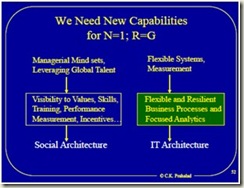N=1 and R=G
I had the chance to listen to business management gurus C.K. Prahalad at the recent London Benchmark for Business event (thanks again Katie). C.K.’s presentation on ‘Realising the Opportunity’ talked about embracing the positive potential of the economic turmoil as being a catalyst for changes that have long been brewing and are primed for embracing all of which echo the core themes of Dynamic Work
1. Fundamentally Change Industry Structures
2. Require New Approaches to Managing
3. Provide Exciting New Opportunities
4. Put a New Premium on Innovation
5. Demand New Organisational Capabilities
He talked about the need for a change in ‘Organisational Capabilities’ from...
1. Hierarchies to Networks
2. Investment Capacity to Collaborative Capacity
3. Organisation Structures to Velcro Organisation
Prahalad concluded that the ‘New Game’ boils down to
- “N-=1”: Co creation of Personalised Experiences
- “R=G”: Multi-institutional and Multi-Geograohic Access to Resources
‘N=1’ or ‘Co-Creation’ is ‘dynamic work’ to the extreme. Making your customers your workers to the benefit of both. In the SOA context, ‘co-creation’ is akin to Microsoft’s “Software Plus Services” (S+S) vision. Combining the power of software (the organisation’s workforce) with tapping into the ‘cloud’ of value add content and services (the customer base).
“R=G” is practically the very definition of Dynamic Work. He describes it as the “Emergence of Nodal Firms and Supply Webs”.
